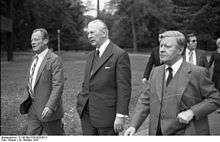Grand coalition (Germany)
In modern Germany, grand coalition (German: Große Koalition) describes a governing coalition of the two main centre-right and centre-left parties, that is the Christian Democrats (consisting of the sister parties CDU and CSU) and the Social Democrats (SPD).[1]
Weimar Republic (1919–1933)
In the Weimar Republic of 1919–1933, the term "grand coalition" was used for a coalition that included the Social Democratic Party, SPD, the Catholic Centre Party and the liberal parties Democratic Party, DDP and People's Party, DVP. Such a coalition was in power in 1923 and in 1928–1930, although the latter was a conglomerate of parties with somewhat conflicting interests, that banded together to as a safeguard for democracy against the radical political parties, the KPD and the NSDAP.
Federal Republic (1949–)

Federal Level
In the post-war politics of Germany, three grand coalitions (Große Koalitionen) have been formed at the federal level through the Bundestag.[2]
Kiesinger cabinet
On 1 December 1966, the government was formed by the Social Democratic Party of Germany and the Christian Democratic Union of Germany, the two major political parties in the Federal Republic of Germany. It was the result of arguments about tax increases between the CDU/CSU–FDP coalition of the time. The FDP ministers stood down and a new government was formed with the SPD under Kurt Georg Kiesinger of the CDU. The grand coalition was in control of 95% of the Bundestag, leaving some politically active students disillusioned; this disillusionment led to the formation of the Außerparlamentarische Opposition which formed a core of the German student movement. The Kiesinger grand coalition lasted until 1969.[3][4]
Merkel cabinets I and III
After the inconclusive result of the 2005 German federal election, neither of the traditional coalitions could form a majority government. Another possible coalition existed, comprising the SPD, Greens, and the Left Party, but a desire to exclude the Left Party from government (i.e. a cordon sanitaire) led the leaders of the SPD and the CDU/CSU to agree to form a grand coalition with CDU leader Angela Merkel as chancellor and an equal number of cabinet seats for each party. The chancellor was elected on 22 November, and the first Merkel Cabinet took office.[5] The second grand coalition in German history ended when, after the 2009 federal election, a coalition was agreed between the CDU/CSU and the FDP, thus forming the second Merkel Cabinet.[6]
Following the 2013 election, on 27 November 2013 a third grand coalition was formed by the CDU/CSU and the SPD.[2] Again it would have been possible to form a SPD–Greens–Left government, but a grand coalition was formed instead. The nickname GroKo (shortening for Große Koalition) was named 2013 word of the year in Germany.[7]
State Level
As of April 2016, Berlin, Mecklenburg-Western Pomerania, Saarland and Saxony are governed by grand coalitions between the CDU and the SPD. At state level grand coalition governments consisting of other parties as the largest two parties in parliament have also occurred: after the 2009 Brandenburg state election, the SPD and the Left party formed a government;[8] after the 2011 Bremen state election, the SPD and the Greens formed a government;[9] and most recently after the 2016 Baden-Württemberg state election, the Greens and the CDU formed a government.[10]
See also
- Historic Compromise (Italy)
- Grand coalition
References
- ↑ "Duden | Koalition | Rechtschreibung, Bedeutung, Definition, Synonyme, Herkunft". www.duden.de (in German). Retrieved 2016-08-20.
- 1 2 "Bundesregierung: Die Große Koalition ist besiegelt" [The grand coalition (deal) is sealed]. Die Zeit (in German). 2013-12-16. ISSN 0044-2070. Retrieved 2016-08-20.
- ↑ "Hintergrund: Die große Koalition 1966-1969" [Background: The grand coalition 1966-1969]. dw.com (in German). Deutsche Welle. 2005-10-15. Retrieved 2016-08-20.
- ↑ Sturm, Daniel Friedrich (2005-09-27). "Wie die erste große Koalition entstand" [How the first grand coalition came about]. Welt Online (in German). Retrieved 2016-08-20.
- ↑ "Kanzler-Wahl: Merkel auf der Zielgeraden" [Chancellor Election: Merkel on the home stretch.]. SPIEGEL ONLINE (in German). Retrieved 2016-08-20.
- ↑ "Reformprogramm: Merkel verspricht weitreichende Entlastung" [Reform Programme: Merkel promises far-reaching relief]. SPIEGEL ONLINE (in German). 2009-10-24. Retrieved 2016-08-20.
- ↑ ""GroKo" ist das Wort des Jahres 2013" ["GroKo" is the word of the year 2013]. Welt Online (in German). 2013-12-13. Retrieved 2016-08-20.
- ↑ "Deutschland: Koalitionsgespräche: Rot-Rot in Brandenburg steht" [Red-Red is in Brandenburg]. badische-zeitung.de (in German). Badische Zeitung. Retrieved 2016-08-20.
- ↑ Exner, Ulrich (2011-05-22). "Rot-Grün – das ist Bremens neue große Koalition" [Red-Green: that's Bremen's new grand coalition]. Welt Online (in German). Retrieved 2016-08-20.
- ↑ "Baden-Württemberg: Kretschmann erneut zum Ministerpräsidenten gewählt" [Kretschmann re-elected MInister-President]. Die Zeit (in German). 2016-05-12. ISSN 0044-2070. Retrieved 2016-08-20.
Further reading
- Helms, Ludger (2006). "The Grand Coalition: Precedents and Prospects". German Politics and Society. 24 (1): 47–66. doi:10.3167/104503006780935234.